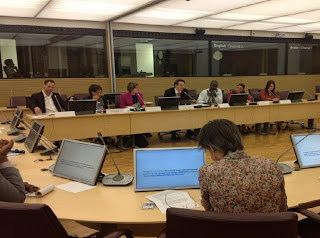| Participants listen to opening statements at the 12th session of the UN Permanent Forum on Indigenous Issues. ©IFAD/Bridget Scallen |
The two-week session began as indigenous peoples, many in traditional clothing, filled the cavernous General Assembly hall at UN headquarters. They were greeted by the melody of an Andean flute and a ceremonial welcome from Chief Sidney Hill of the Native American Onondaga Nation. A series of speakers followed, outlining the objectives and aspirations of the Permanent Forum, which serves as the UN Economic and Social Council’s advisory body on indigenous peoples’ rights and issues.
Several of the speakers noted that the current session of the Permanent Forum would play an important role in setting the agenda for the World Conference on Indigenous Peoples, to be held in September 2014. Several also asserted that indigenous peoples’ traditional knowledge – and their vision of sustainable development based on respect for culture, identity and the environment – must be integral to the global agenda that will follow the Millennium Development Goals after the MDGs’ target date passes in 2015.
Platform for dialogue
The theme of sustainable development in indigenous communities figured prominently in two IFAD-related side events that followed the opening session. The first of those events was a review of IFAD’s engagement with indigenous peoples and the findings of its Indigenous Peoples’ Forum, which held an inaugural global meeting in Rome this past February (see video at the bottom of this post).
| Panel at UN Permanent Forum side event on IFAD's engage- ment with indigenous peoples. ©IFAD/Bridget Scallen |
The Indigenous Peoples Forum at IFAD is an outgrowth of the policy’s emphasis on full partnership. While the Forum is scheduled to convene a global meeting every other year, Cordone stressed that it is not primarily a meeting but, rather, a process. “It is a platform of continuous dialogue between IFAD and indigenous peoples at the regional, national and international levels,” she said.
A starting point
A panel of indigenous peoples’ leaders spoke at the side event, representing grassroots organizations that are engaged in just such a dialogue with IFAD in Africa, Asia and the Pacific, and Latin America and the Caribbean. The leaders agreed that the Indigenous Peoples’ Forum is a vehicle for meaningful cooperation on reducing poverty and increasing food security in some of the world’s most marginalized communities. They cautioned, however, that it is still just a starting point for improving the lives of millions of indigenous women and men in poor rural areas.
| Devasish Roy, a member of the UN Permanent Forum, at one of the IFAD-related events. ©IFAD/Bridget Scallen |
Joan Carling, Secretary-General of Asia Indigenous Peoples Pact, added that IFAD has a critical role to play in advocating for recognition of indigenous peoples’ rights. “Land tenure is at the heart of indigenous peoples’ food security,” she said, citing the need for national policies that ensure access to ancestral land and resources. Indigenous women’s empowerment is another area that urgently needs attention, Carling said.
“It’s not enough to have a policy on indigenous peoples,” concluded Myrna Cunningham, a Nicaraguan activist and member of the Permanent Forum on Indigenous Issues. “Policies have to be accompanied by mechanisms for implementation.” Such mechanisms, she said, require indigenous peoples’ participation at every level, as well as adequate resources to make a significant impact on the ground.
Self-driven development
One existing mechanism for implementation – the Indigenous Peoples Assistance Facility (IPAF) – was the subject of the second IFAD-related side event held at the Permanent Forum yesterday. Established in 2007, the facility aims to strengthen indigenous peoples’ communities and organizations by financing small projects that foster self-driven development. In the process, these projects generate innovative approaches to rural development that potentially can be replicated and scaled up.
| UN Permanent Forum participants confer in the Trusteeship Council Chamber at UN headquarters, New York. ©IFAD |
The IPAF side event featured representatives from indigenous peoples’ organizations that co-manage the facility with IFAD in the various regions where it works, as well as partners implementing projects with IPAF grants. In a series of presentations, they demonstrated how IPAF support has helped their communities apply traditional knowledge about sustainable agriculture to enhance rural livelihoods and food security. One presenter, Gregory Juan Ch’oc of the Sarstoon Temash Institute for Indigenous Management, in Belize, praised IPAF for enabling indigenous peoples to pursue “development with identity” in the face of the historic suppression of their cultural heritage.
As the Permanent Forum on Indigenous Issues continues in the coming days, IFAD and its partners will be looking toward a future in which development with identity is not the exception but, instead, the rule for indigenous peoples worldwide.
VIDEO: Indigenous Peoples' Forum
Watch a recap of the first global meeting convened by the Indigenous Peoples' Forum at IFAD in February 2013. The video was screened to a visibly moved audience yesterday at the UN Permanent Forum on Indigenous Issues.




























